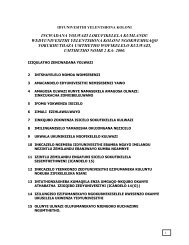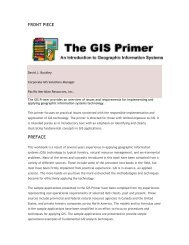Ecosystem Guidelines for Environmental Assessment
Ecosystem Guidelines for Environmental Assessment
Ecosystem Guidelines for Environmental Assessment
You also want an ePaper? Increase the reach of your titles
YUMPU automatically turns print PDFs into web optimized ePapers that Google loves.
SCEPS<br />
ecosystems (e.g. Granite Fynbos, Limestone<br />
Fynbos-Sand Fynbos mosaics or wetlands) when<br />
undertaking environmental assessments <strong>for</strong><br />
projects that may impact on spatial components<br />
of ecological processes.<br />
Prioritise restoration and alien clearance in<br />
degraded habitat linkages that would otherwise<br />
be lost if neglected.<br />
Attempt to align trans<strong>for</strong>med areas "with the<br />
grain" of the ecological corridor or vegetation<br />
boundary that is being conserved, i.e. avoid<br />
severing habitat linkages in ecological corridors<br />
or destroying indigenous vegetation along the<br />
entire front of a soil interface.<br />
Where there are obvious vegetation boundaries<br />
which reflect soil interfaces, upland-lowland<br />
interfaces or, in the Thicket Biome, solid thicketnon<br />
thicket boundaries, these interfaces should Aim to accommodate vegetation boundaries and ecological<br />
corridors within projects.<br />
be maintained and accommodated within a spatial<br />
plan or project proposal.<br />
Similarly, riverine corridors and sand movement corridors should be buffered, conserved and<br />
accommodated within a spatial plan or project proposal.<br />
Consult CapeNature <strong>for</strong> input into environmental assessments or biodiversity studies in spatial<br />
components of ecological processes.<br />
JAN VLOK<br />
7<br />
Land-use guidelines <strong>for</strong> spatial components of ecological processes<br />
The following low-intensity land-uses may, subject to the appropriate biodiversity assessments and<br />
environmental management, be compatible with maintaining healthily functioning ecological corridors<br />
and vegetation boundaries:<br />
- Biodiversity conservation<br />
- Recreational infrastructure (hiking, mountain biking, horse trails, 4X4 tracks)<br />
- Game farming<br />
- Grazing<br />
- Ecologically sustainable harvesting of natural vegetation<br />
- Cultivation that avoids irreversible impairment of ecosystem functioning (e.g. strip cultivation<br />
rather than centre-pivot irrigation).<br />
Sprawling urban and township development and resorts should be discouraged, especially alienation<br />
of land units through any <strong>for</strong>m of subdivision, sectional title, share block or similar schemes.<br />
CONSULT THE RELEVANT ECOSYSTEM GUIDELINES FOR MORE DETAILED<br />
RECOMMENDATIONS ABOUT DEVELOPMENT PLANNING IN SPECIFIC ECOSYSTEMS<br />
COLIN PATERSON-JONES<br />
86 : SPATIAL COMPONENTS OF ECOLOGICAL PROCESSES
















